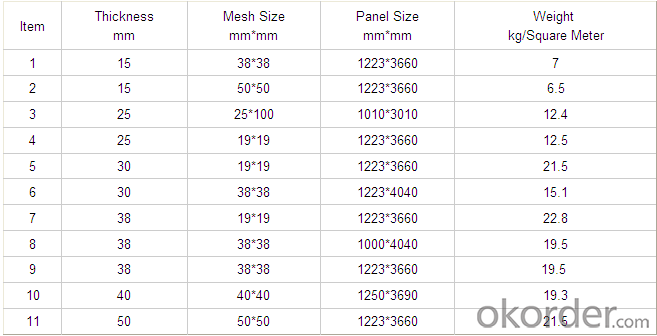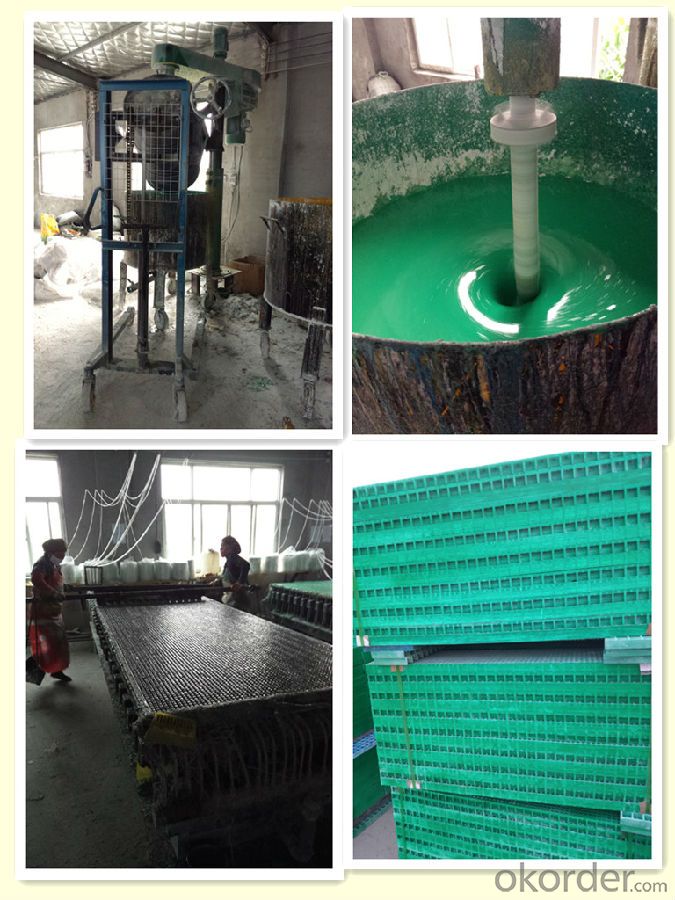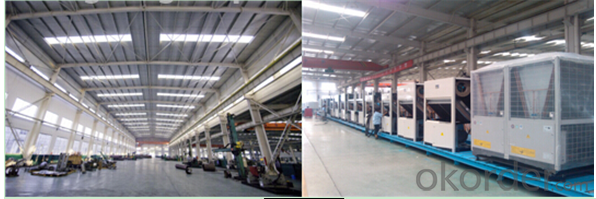FRP Grating for Walkway with Popular Color with Best Quality
- Loading Port:
- China main port
- Payment Terms:
- TT OR LC
- Min Order Qty:
- 100 m²
- Supply Capability:
- 500000 m²/month
OKorder Service Pledge
OKorder Financial Service
You Might Also Like
Introduction
FRP Molded Grating is a structural panel which uses high-strength E-Glass roving as reinforcing material, thermosetting resin as matrix and then casted and formed in a special metal mold. It provides properties of light weight, high strength, corrosion resistance, fire resistance and anti-skid. FRP Molded Grating is widely used in oil industry, power engineering, water & waste water treatment, ocean survey as working floor, stair tread, trench cover, etc. and is an ideal loading frame for corrosion circumstances.
Feature
l Corrosion Resistance
l Fire Resistance
l Light Weight & High Strength
l Safety & Anti-slip
l Electrical Insulating
l Aging Resistance
Specification

Advantage
1) coated with prevent aging layer
2) excellent insulating performance
3) no maintenance
4) high strength
5) long service life
6) easy installation
Application
l Power plants, substation equipment enclosures, antimagnetic, anti-static,to prevent small animals into the equipment failure, as there is electricity facilities and without power interval intervals.
l In high voltage electrical equipment for power line work, in order to prevent workers go wrong location, charged interval or near electrically charged equipment to dangerous distance.
l Pool railings in sewage treatment industry
l Corrosive chemical industry equipment around the fence
l All kinds of building maintenance section
FAQ
1. How about the documents after shipment?
After shipment, we ll send all original documents to you by DHL, including Packing List.Commercial Invoice, B/L, and other certificates as required by clients.
2. How long is the delivery time?
Usually it takes 10-25days after receipt of the deposits or L/C, and it also depends on the quantity of your order.
3. How's the payment?
Telegraphic Transfer(T/T) or Letter of Credit(L/C)
4. Do You Arrange Shipment?
Yes, dear esteemed customers, for FOB or CIF price, we will arrange shipment for you. For EXW price, clients need to arrange shipment by themselves or their agents.
5. How is the package?
Usually, we arrange the standard out-package for exporting.
PROCESS

FACTORY


- Q:Are FRP pultrusion profiles resistant to mold and mildew?
- Yes, FRP (Fiber Reinforced Plastic) pultrusion profiles are generally resistant to mold and mildew. FRP is a composite material made of a polymer matrix reinforced with fibers, typically glass fibers. Unlike organic materials such as wood or traditional plastics, FRP does not provide a suitable environment for mold and mildew growth. The inherent properties of FRP, such as its non-porous nature and resistance to moisture absorption, make it highly resistant to mold and mildew. Additionally, FRP pultrusion profiles are often manufactured with a smooth and glossy surface, which further inhibits the growth of mold and mildew. Furthermore, FRP is chemically inert, meaning it does not react with most substances. This characteristic makes FRP profiles highly resistant to chemical attacks, including those that may promote the growth of mold and mildew. As a result, FRP pultrusions are commonly used in environments where moisture and humidity are present, such as bathrooms, swimming pools, and outdoor applications. However, it is important to note that while FRP is resistant to mold and mildew, it is not completely immune. In certain extreme conditions, where moisture levels are consistently high and proper maintenance is neglected, mold and mildew growth may still occur. Regular cleaning and maintenance are recommended to ensure the longevity and resistance of FRP pultrusion profiles to mold and mildew.
- Q:Do FRP pultrusion profiles have any limitations or drawbacks?
- Yes, FRP pultrusion profiles do have some limitations and drawbacks. One limitation is their susceptibility to UV degradation, which can cause discoloration and reduced mechanical properties over time if not properly protected. Additionally, FRP pultrusion profiles have relatively low impact resistance compared to materials like steel or aluminum. They may also have limited fire resistance and can melt or burn under high temperatures. Finally, the manufacturing process for FRP pultrusion profiles can be time-consuming and expensive, making it less suitable for small-scale or customized applications.
- Q:Are FRP pultrusion profiles resistant to high winds or hurricanes?
- Yes, FRP pultrusion profiles are resistant to high winds and hurricanes. The inherent strength and durability of fiberglass reinforced plastic (FRP) combined with the pultrusion manufacturing process make these profiles highly resistant to extreme weather conditions, including high winds and hurricanes. They have been extensively tested and proven to withstand strong winds and turbulent weather events.
- Q:Can FRP pultrusion profiles be used in the construction of industrial flooring?
- Indeed, the utilization of FRP (Fiber Reinforced Polymer) pultrusion profiles is viable in the construction of industrial flooring. These profiles are comprised of a composite material, combining robust fibers (usually glass or carbon) with a polymer resin. This amalgamation of materials imparts exceptional strength, durability, and resistance to corrosion, rendering FRP profiles highly suitable for industrial flooring applications. The primary benefit of FRP pultrusion profiles lies in their remarkable strength-to-weight ratio. Consequently, they are lighter and more manageable compared to conventional materials like steel or concrete. Moreover, FRP profiles possess non-conductive and non-magnetic properties, offering advantages in specific industrial environments. FRP pultrusion profiles also exhibit high resistance to various chemicals, moisture, and UV radiation, making them an ideal choice for harsh and corrosive settings. Unlike steel, they do not rust or corrode, nor are they affected by moisture or rot like wood. As a result, they ensure long-lasting performance and necessitate minimal maintenance. Additionally, FRP profiles can be customized and manufactured in diverse shapes, sizes, and load-bearing capacities to meet specific industrial flooring requirements. They can be designed to withstand heavy loads, impact, vibration, and other dynamic forces commonly encountered in industrial settings. In conclusion, FRP pultrusion profiles offer numerous advantages that make them well-suited for the construction of industrial flooring. Their high strength, durability, corrosion resistance, and customizable nature make them a dependable and cost-effective choice for industrial flooring applications.
- Q:Can FRP pultrusion profiles be used for structural applications?
- Yes, FRP pultrusion profiles can be used for structural applications. They are commonly utilized in various industries such as construction, automotive, aerospace, and marine. FRP pultrusion profiles offer high strength-to-weight ratio, excellent corrosion resistance, and durability, making them suitable for structural components like beams, columns, and trusses. Additionally, they can be designed to meet specific load requirements and offer design flexibility.
- Q:What are the quality control measures for FRP pultrusion profiles?
- To ensure the desired standards are met, a series of steps and processes are involved in quality control measures for FRP pultrusion profiles. These measures encompass: 1. Inspection of raw materials: The initial step involves verifying the quality of the raw materials used in the pultrusion process. This entails assessing the properties and specifications of components such as fiberglass, resin, additives, and others. 2. Control of the process: Throughout the pultrusion process, it is crucial to monitor and control various parameters. This includes maintaining consistent temperature, pressure, and resin content during impregnation, forming, and curing stages. 3. Testing of samples: Regular sampling is conducted during production to evaluate profile quality. Mechanical properties, dimensional accuracy, and surface finish are tested to ensure they align with the required standards. 4. Visual examination: Each profile undergoes visual inspection to identify any defects, such as cracks, voids, delamination, or surface imperfections. This examination aids in detecting irregularities that may impact the profiles' structural integrity or aesthetics. 5. Mechanical assessment: Profiles are subjected to mechanical testing to evaluate strength, stiffness, and other mechanical properties. Flexural, tensile, impact, and compression tests are conducted, comparing the results to specified requirements to determine compliance with necessary standards. 6. Documentation of quality: Proper documentation is maintained throughout the manufacturing process, encompassing records of raw material specifications, process parameters, test results, and inspection reports. This ensures traceability and serves as a reference for quality assurance. 7. Non-destructive testing: In addition to mechanical testing, non-destructive techniques like ultrasonic testing or X-ray inspection may be employed to identify internal defects or inconsistencies without causing damage to the profiles. 8. Quality audits: Regular internal and external audits are performed to evaluate the effectiveness of quality control measures and ensure adherence to relevant industry standards and regulations. By incorporating these quality control measures, manufacturers can guarantee that FRP pultrusion profiles meet the necessary specifications, resulting in dependable and high-quality products.
- Q:Are FRP pultrusion profiles resistant to chemicals used in food packaging?
- FRP pultrusion profiles have proven to be highly resistant to chemicals typically employed in the realm of food packaging. Their remarkable ability to withstand a vast array of chemicals, including acids, bases, solvents, and oils, is well-documented. Consequently, FRP pultrusion profiles are a fitting option for applications that necessitate interaction with food packaging materials. Nevertheless, it is crucial to acknowledge that the chemical resistance of FRP profiles may differ based on the formulation and type of resin utilized. Consequently, it is prudent to seek guidance from the manufacturer or supplier to ensure that the chosen FRP pultrusion profiles are compatible with the specific chemicals employed within the food packaging industry.
- Q:Plastic or better glass fiber reinforced plastic better?
- Glass fiber reinforced plastics, usually glass fiber reinforced unsaturated polyester, epoxy resin and phenolic resin matrix. Because of the different kinds of resins used, they are called polyester glass fiber reinforced plastics, epoxy glass fiber reinforced plastics and phenolic resin glass fiber reinforced plastics. Its characteristics are: light and hard, non conductive, stable performance, high mechanical strength, less recycling and corrosion resistance. It can be used instead of steel to make machine parts, automobiles, ship shells, etc..
- Q:Are FRP pultrusion profiles resistant to impact and vibration?
- Yes, FRP pultrusion profiles are generally resistant to impact and vibration due to their high strength-to-weight ratio and excellent flexural properties. The composite material used in the pultrusion process provides inherent toughness and durability, making FRP profiles suitable for applications where impact and vibration resistance are important considerations.
- Q:Are FRP pultrusion profiles resistant to moisture or humidity?
- FRP pultrusion profiles boast exceptional resistance to moisture and humidity. Through the pultrusion process, continuous fibers are thoroughly saturated with a polymer resin, resulting in a steadfast and enduring composite material. This composite possesses inherent moisture resistance, differing from conventional materials like wood or metal, as it does not absorb water. Moreover, FRP pultrusion profiles exhibit a minimal coefficient of thermal expansion, minimizing the likelihood of expansion or contraction in response to varying humidity levels. This moisture and humidity resistance render FRP pultrusion profiles suitable for a diverse array of applications, including outdoor structures, marine environments, and other areas prone to moisture.
1. Manufacturer Overview |
|
|---|---|
| Location | |
| Year Established | |
| Annual Output Value | |
| Main Markets | |
| Company Certifications | |
2. Manufacturer Certificates |
|
|---|---|
| a) Certification Name | |
| Range | |
| Reference | |
| Validity Period | |
3. Manufacturer Capability |
|
|---|---|
| a)Trade Capacity | |
| Nearest Port | |
| Export Percentage | |
| No.of Employees in Trade Department | |
| Language Spoken: | |
| b)Factory Information | |
| Factory Size: | |
| No. of Production Lines | |
| Contract Manufacturing | |
| Product Price Range | |
Send your message to us
FRP Grating for Walkway with Popular Color with Best Quality
- Loading Port:
- China main port
- Payment Terms:
- TT OR LC
- Min Order Qty:
- 100 m²
- Supply Capability:
- 500000 m²/month
OKorder Service Pledge
OKorder Financial Service
Similar products
New products
Hot products
Hot Searches
Related keywords



























